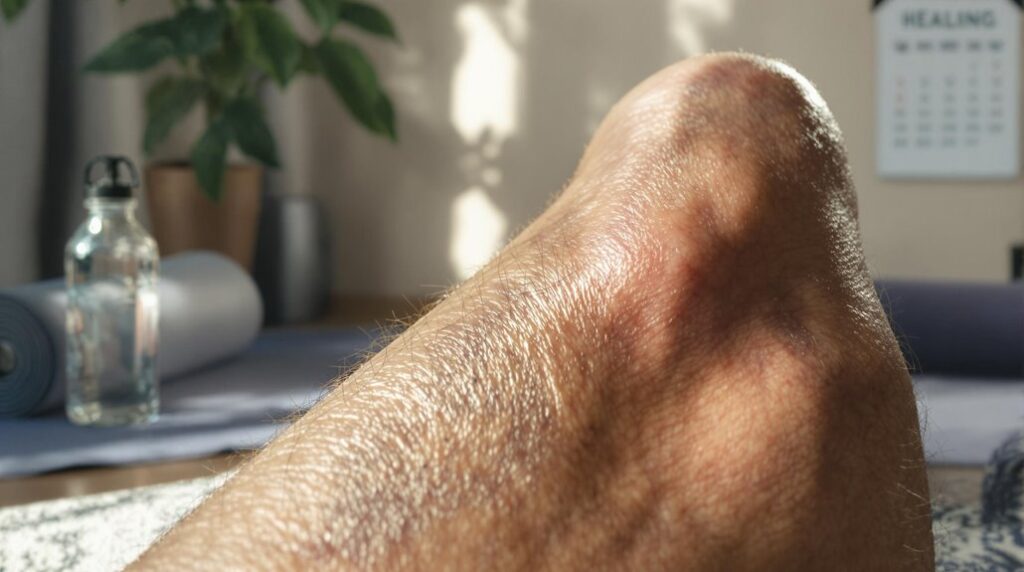A pulled muscle, or muscle strain, heals based on its severity. Grade one strains typically recover in one to two weeks, while grade two strains may require two to six weeks. In contrast, grade three strains can take several months, often needing surgical intervention. Recovery times vary considerably depending on individual health factors and adherence to treatment protocols. To understand how to manage and prevent future injuries, exploring further information on rehabilitation and physiotherapy is essential.
Understanding Muscle Strains
Muscle strains, often referred to as pulled muscles, occur when the fibers in a muscle are overstretched or torn. These injuries can happen during physical activities, especially if you haven't properly warmed up. Symptoms typically include pain, swelling, tenderness, weakness in the affected muscle, and sometimes bruising. The severity of a muscle strain is usually classified into three grades, with grade one being minor damage and grade three representing a complete tear. Recovery time varies greatly, ranging from a few weeks for mild strains to several months for more severe instances. During the first four to six weeks post-injury, the risk of re-injury increases, making careful rehabilitation essential for a safe return to activity.
Grading of Muscle Strains
When evaluating the severity of a muscle strain, it's vital to take into account the grading system that classifies these injuries into three distinct categories. Grade one involves slight damage, presenting minor pain and normal strength. In contrast, grade two indicates more significant muscle fiber injury, often accompanied by pain, swelling, and some loss of strength. Finally, grade three strains represent a complete muscle tear, characterized by severe pain, significant swelling and bruising, along with complete loss of strength. Understanding this grading is essential for determining the appropriate treatment and recovery plan, as grade one strains typically heal within a few weeks, while grade two may take several weeks to months, and grade three often requires longer recovery periods, possibly involving surgery.
Symptoms of a Pulled Muscle
Experiencing a pulled muscle can lead to a range of symptoms that vary in intensity depending on the severity of the strain. You might notice pain in the affected area, which can range from minor discomfort to severe agony. Tenderness upon touch often accompanies this pain, along with potential swelling or bruising. Weakness in the muscle can occur, affecting your ability to perform daily activities or participate in sports. Muscle spasms or cramping may also arise, indicating painful tightening in the area. Symptoms typically manifest immediately after the injury and can last longer depending on the strain's severity. Recognizing these symptoms is essential for determining the appropriate treatment and recovery measures to follow.
Typical Healing Times for Muscle Strains
Healing times for muscle strains vary considerably based on the severity of the injury. A grade one muscle strain, characterized by slight damage, usually heals within a few days to two weeks, as you may experience minor pain and retain normal strength. In contrast, a grade two strain can take two to six weeks, involving more significant muscle fiber injury, along with increased pain and swelling. For grade three strains, which are full muscle tears, recovery may extend to several months, often necessitating medical intervention like surgery or extensive rehabilitation. Keep in mind that individual factors, such as age and overall health, also influence recovery times, so it's important to avoid aggravating activities during the initial healing phase.
Treatment Options for Muscle Strains
Recovering from a muscle strain requires implementing effective treatment options tailored to the severity of the injury. Initially, you should use the POLICE method—rest, ice, compression, and elevation—to minimize pain and swelling. Over-the-counter painkillers, like ibuprofen or acetaminophen, can help alleviate discomfort and reduce inflammation during the first few days. For more severe or recurring strains, healthcare providers may recommend physiotherapy, which includes customized exercises aimed at improving strength and flexibility. Although surgery is rare, it might be necessary for complete tears; in such cases, follow-up physiotherapy is essential for effective recovery. Keep in mind that recovery time varies, with mild strains healing in weeks, while severe strains can take several months to fully recover.
Importance of Rehabilitation and Physiotherapy
While muscle strains can be painful and limiting, engaging in rehabilitation and physiotherapy is essential for ensuring a successful recovery. These practices play a vital role in restoring strength, flexibility, and functionality to the injured area. By participating in tailored physiotherapy exercises, you can greatly reduce recovery time, often returning to normal activity weeks sooner than without rehabilitation. A structured program usually involves gradually loading the injured muscle, which aids in rebuilding strength and preventing future injuries. Physiotherapists provide guidance on proper techniques that minimize the risk of re-injury during the critical four to six weeks post-strain. Regular physiotherapy sessions improve overall recovery outcomes, ensuring a more complete healing process and better long-term muscle health.
Tips for Preventing Future Muscle Strains
Preventing future muscle strains requires a proactive approach that focuses on preparation and body awareness. Start by warming up properly before any physical activity; gentle movements help prepare your muscles and reduce strain risks. Gradually increase the intensity and duration of your workouts, allowing your muscles to adapt and strengthen over time. Incorporate flexibility and strength training exercises into your routine, as these enhance muscle resilience and help prevent injuries. Additionally, use appropriate sports equipment and footwear that provide adequate support and cushioning for your specific activity. Finally, listen to your body; avoid pushing through pain or fatigue, since tired muscles are more susceptible to injury. By following these tips, you can greatly reduce your risk of muscle strains.

